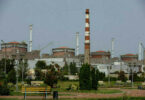Monitoring Desk
The car-sized Perseverance landed on the floor of Jezero Crater on Feb. 18, kicking off an ambitious surface mission that will hunt for signs of ancient Mars life and collect samples for future return to Earth, among other tasks.
Perseverance is not yet ready to dive into that science work; the mission team is still conducting health and status checks on its various instruments and subsystems. But the six-wheeled robot recently used its Mastcam-Z camera suite to capture a high-definition, 360-degree panorama of its surroundings, and that first taste has the mission team intrigued.

For example, the zoomable panorama revealed a dark stone that the team has dubbed “Harbor Seal Rock,” Mastcam-Z principal investigator Jim Bell, of Arizona State University’s School of Earth and Space Exploration, said during a webcast discussion of the photo on Thursday (Feb. 25).
The Martian wind probably carved Harbor Seal Rock into its curious shape over the eons, Bell said. He also pointed out patches that showed evidence of much faster-acting erosion — spots where the thrusters on Perseverance’s “sky crane” descent stage blew away Mars’ blanket of red dust on Feb. 18, exposing the surfaces of small rocks.
One such patch harbors a group of light-colored, heavily pitted stones that have caught mission scientists’ eyes.
“Are these volcanic rocks? Are these carbonate rocks? Are these something else? Do they have coatings on them?” Bell said. “We don’t know — we don’t have any chemical data or mineral data on them yet — but, boy, they’re certainly interesting, and part of the story about what’s going on here is going to be told when we get more detailed information on these rocks and some of the other materials in this area.”
This is one of the key jobs of Mastcam-Z and Perseverance’s other cameras, Bell said — to spot interesting features that Perseverance can study in more detail with its spectrometers and other science instruments.
The 28-mile-wide (45 kilometers) Jezero Crater harbored a deep lake and a river delta billions of years ago. Deltas are good at preserving signs of life here on Earth, so the Perseverance team is eager for the rover to study and sample the remnants of that feature within Jezero. And the delta is visible in the Mastcam-Z panorama; the cliffs that mark its edge are about 1.2 miles (2 kilometers) from Perseverance’s landing site, Bell said.
The ridgeline that’s visible beyond the delta cliffs in the Mastcam-Z panorama is Jezero Crater’s rim, he added.
The recently unveiled photo is just the beginning, of course. For starters, it’s the lowest-resolution panorama the Mastcam-Z team will construct. Bell said that similar shots that are three times sharper will be assembled after Perseverance switches over to its surface-optimized software, a four-day process that’s already underway.
And we haven’t gotten the slightest taste of Perseverance’s science discoveries yet. That work will take a while to get going, because the mission team’s first big task after getting the rover up and running is to conduct test flights of the 4-lb. (1.8 kilograms) Mars Helicopter Ingenuity, which rode to the Red Planet on Perseverance’s belly.
Ingenuity’s pioneering sorties — the first rotorcraft flights on a world beyond Earth — will likely take place this spring, and science and sampling are expected to begin in earnest in the summer, mission team members have said.
Courtesy: Space.com






